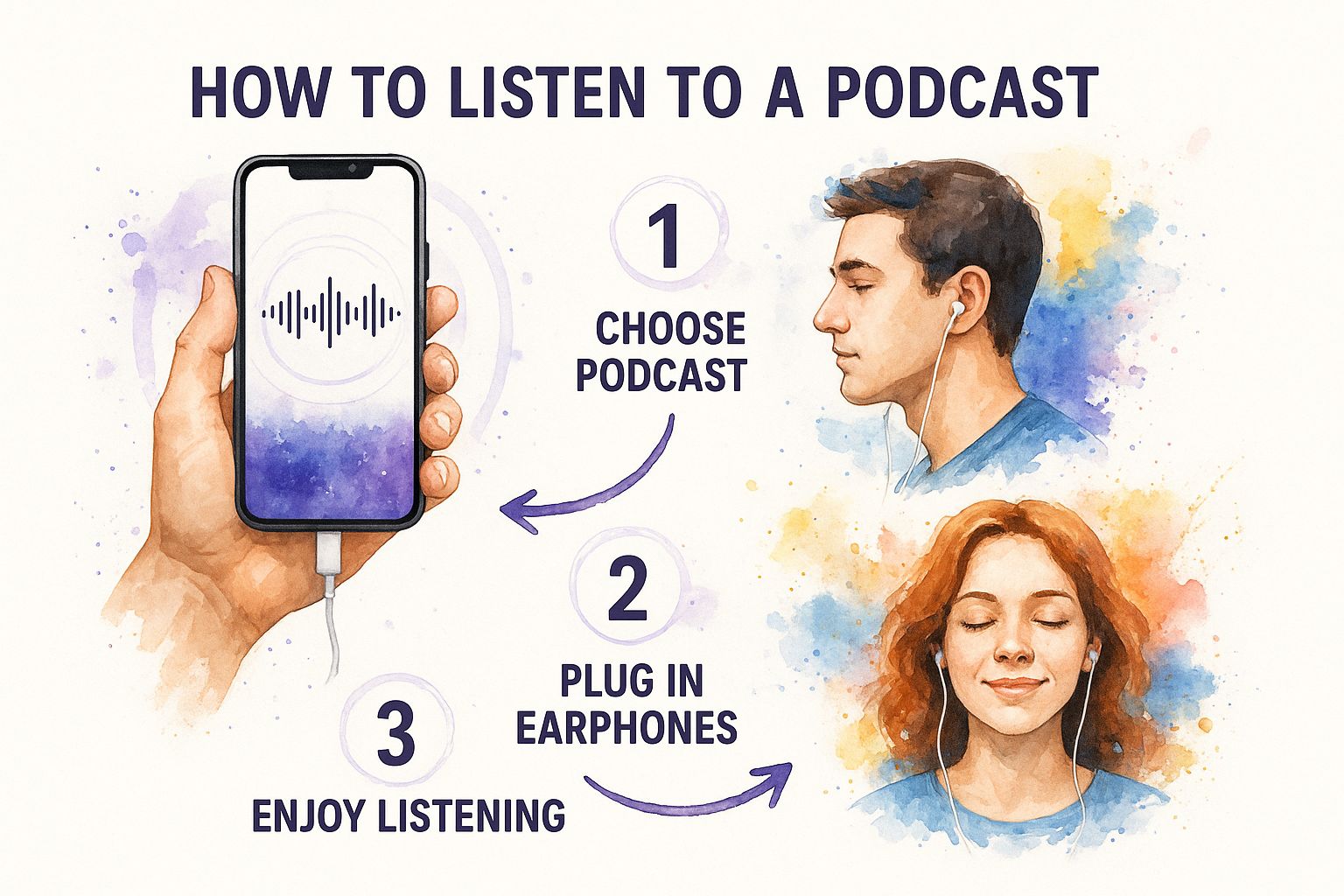How to Improve English Listening Skills: Top Strategies
Learn how to improve English listening skills effectively. Discover proven tips and techniques to enhance your understanding and boost confidence.


If you really want to get better at understanding spoken English, you have to move beyond just hearing the words. It's about actively engaging with the sounds, the rhythm, and the meaning behind them. The best way I've found to do this is by mixing regular exposure to real-world English with focused exercises like transcription and shadowing. This turns listening from a chore into a skill you can consciously build.
Why Your English Listening Skills Are Stuck

Does this sound familiar? You've spent countless hours with English movies, podcasts, or music, but you still feel like you're not making real progress. It's a common feeling, and trust me, you're not alone. There's a good reason why so many learners hit this wall.
The problem usually isn't a lack of effort; it's the kind of effort. Just having English on in the background is passive hearing, not active listening. To truly improve, your brain needs focused training to process what it's hearing in real-time—piecing together sounds, recognizing patterns, and making sense of it all on the fly.
The Imbalance in How We Learn
Think back to how you learned English. For many of us, the classroom focus was heavily skewed toward reading and writing. This creates a huge imbalance. The skills you need to read a sentence quietly to yourself are worlds away from what you need to understand that same sentence spoken by a native at conversational speed.
This isn't just a feeling; it's backed by research. One major study revealed that students' reading skills often race ahead of their listening abilities, even after years of instruction. Why? Because typical school programs are packed with written exercises but light on listening practice. The same OECD report found that the gap closes when listening is specifically targeted in the curriculum.
Because of this gap in traditional education, many of us never properly developed the foundational skills for understanding spoken English, like:
- Phonemic Awareness: The ability to hear the subtle difference between words like "ship" and "sheep."
- Understanding Connected Speech: Catching how native speakers naturally blend words, like turning "going to" into "gonna."
- Interpreting Intonation and Stress: Picking up on the meaning hidden in a speaker's tone of voice.
The real challenge isn't just a lack of exposure; it's learning to manage the cognitive overload from fast speech, unfamiliar accents, and the constant flow of new information.
Once you understand these roadblocks, you can stop wasting time on passive listening and start building a real strategy. Shifting to active, focused techniques is how you finally break through that plateau. It builds the solid comprehension you need before you can confidently jump in and practice English conversation for free with other speakers.
Making the Leap From Passive Hearing to Active Listening
To get genuinely better at understanding spoken English, you have to make one crucial shift in your mindset. It’s all about moving from passively hearing the sounds to actively listening for the meaning behind them.
Think of it this way: passive hearing is like having the radio on in the background. You know it’s there, but you're not really taking it in. Active listening is leaning in, focusing, and trying to pull the message out of the words. It's about engagement, not just exposure.
This is a conscious effort. It means you're not just waiting for your turn to talk; you're completely tuned in to the words, the speaker's tone, and what they're really trying to say. That's where true comprehension starts to happen.
Have a Goal Before You Hit Play
Before you dive into a podcast episode or jump into a conversation, take a second to ask yourself, "What am I trying to get out of this?" Without a clear goal, it's way too easy for your mind to drift. Setting a purpose turns a casual listen into a focused training session.
For instance, your goal could be something specific like:
- Nailing the Main Idea: Can you boil down what you just heard into a single sentence?
- Catching Key Details: Try listening just for names, dates, numbers, or other important facts.
- Figuring Out the Vibe: Is the speaker excited? Sarcastic? Serious? Angry?
Just setting this small intention before you start helps prime your brain to pay attention. You start listening with a purpose, which is exactly what we do in real life. It’s a simple but powerful technique.
The “Listen, Pause, Reflect” Method
Let's be honest, trying to keep up with a long stream of fast, natural English can feel impossible. That's where the "Listen, Pause, Reflect" method comes in. It breaks the firehose of information down into manageable sips.
Here’s the breakdown:
- Listen: Play just a tiny piece of audio. Seriously, 15 to 30 seconds is perfect.
- Pause: Hit the pause button. Resist the urge to immediately hit rewind.
- Reflect: In that silence, ask yourself what you actually understood. Can you summarize it? Did any specific words or phrases stick out? Then, and only then, play it back to see how you did.
This approach forces your brain to work with small, digestible chunks of information. Instead of getting overwhelmed and giving up, you build up your understanding piece by piece. It's a huge confidence booster.
Use Transcripts as a Learning Tool, Not a Crutch
Transcripts can be your best friend or your worst enemy. If you just read along while listening, you're really just practicing reading. The whole point is to train your ears, not your eyes.
A much smarter way to use them is as a review tool after you've given it a real shot. Listen to a clip a few times on its own, trying your best to make sense of it.
Then, pull up the transcript. You can check what you got right, pinpoint new words, and figure out exactly why you misheard a certain phrase. This turns the transcript from a crutch into a powerful feedback loop, helping you finally connect the sounds you hear with the words on the page.
How to Use Podcasts to Build a Real Listening Habit
Podcasts are an absolute goldmine of authentic English, but let’s be honest—just having them on in the background isn't going to cut it. If you want to see a real jump in your listening skills, you need to turn passive listening into an active workout for your brain. It's all about shifting from just hearing the words to truly engaging with them.
The secret isn’t grinding through a full hour-long episode. The magic really happens when you take a small, manageable clip and work with it intentionally, listening over and over again.
Finding a Podcast That Clicks
First things first, you have to find a show that actually works for your current level. If you're just starting out, seek out podcasts made specifically for learners. They usually speak a bit slower and use more common vocabulary. Once you feel more confident, you can dive into native-level content about things you genuinely find interesting, whether that's tech, history, or even baking.
Don't aim for 100% comprehension right away. The sweet spot is finding something that challenges you just enough to stretch your abilities, but not so much that you're totally lost. That's where the real growth happens.
This infographic lays out a simple but powerful three-step method for your practice sessions.

As you can see, each listen has a different purpose, moving from the big picture to the finer details, which helps build a much deeper understanding.
Why Repetition Is Your Superpower
So you've picked a podcast and have a short clip—maybe a minute or two. Now it's time for the active listening cycle. The idea is simple: listen to that same little segment multiple times, but change your focus with each pass.
This isn’t just a nice theory; it’s backed by research. One study with intermediate English learners showed incredible results from an 11-week program of repeated listening. Their average comprehension scores skyrocketed from 61.05 to 86.63. This shows just how effective a structured approach can be. You can dive into the full research on podcast-based learning to see the data for yourself.
A structured approach helps you get the most out of every minute you spend listening. This table breaks down a simple strategy you can adapt based on your current proficiency.
Podcast Listening Strategy for Different Levels
| Proficiency Level | Recommended Podcast Type | Active Listening Exercise |
|---|---|---|
| Beginner (A1-A2) | Podcasts for learners (e.g., ESL Pod, Learning English from VOA) | Listen for familiar words. Pause and repeat simple sentences. |
| Intermediate (B1-B2) | Topic-based shows with clear speakers (e.g., NPR, TED Talks Daily) | Summarize a 2-minute clip in 1-2 sentences. Transcribe one sentence you find difficult. |
| Advanced (C1-C2) | Native-level content with slang, accents (e.g., comedy, interviews) | Shadow the speaker for 30 seconds to match their intonation. Note down 3 new idioms or phrases. |
By tailoring the content and the exercise to your level, you ensure you're always pushing yourself in a productive way.
Your Go-To Listening Routine
With this repetition strategy, any podcast clip can become a powerful mini-lesson. Here’s a simple routine to get you started:
- First Pass: Get the Gist. Play the clip once without stopping. Just ask yourself one thing: "What was that about?" Don’t get hung up on words you miss.
- Second Pass: Hunt for Details. Listen again. This time, try to catch specific bits of information—names, numbers, places, or key ideas. Jot down a few keywords.
- Third Pass: Dig for Vocabulary. On your final listen, zero in on new words or expressions. Hit pause, look them up, and then listen one last time to hear them used in context.
Want to take it even further? Try summarizing the clip out loud in your own words or practice shadowing—repeating what the host says just after they say it. This not only sharpens your listening but also dramatically improves your pronunciation and fluency.
These active exercises are what bridge the gap between understanding and speaking, setting you up for successful English conversation practice online where you can put it all into action.
Taming the Overwhelm: How to Think Like a Native Listener
We’ve all been there. You’re trying to follow a native speaker, and the words are just flying by. Your brain frantically tries to grab onto every single one, and within minutes, you're exhausted and completely lost. That mental burnout? It's a real thing called cognitive overload.
The good news is, you can get past it. The solution isn't just about forcing yourself to listen more; it’s about learning to listen smarter. With a few mental tricks, you can train your brain to handle fast speech without shutting down.
Give Your Brain a Heads-Up
Think about it: would you start a marathon without stretching? Probably not. The same idea applies to listening. Diving into a conversation "cold" forces your brain to juggle multiple tasks at once: decoding sounds, recalling vocabulary, and figuring out the topic, all in real-time. It's no wonder you get overwhelmed.
Before you press play on a video or join a meeting, give your brain a little warm-up. If you're about to watch a news clip about a new technology, spend 30 seconds reading the headline and the first sentence. This simple act gives you context. It clues your brain into the topic and potential vocabulary, freeing up mental energy to focus on understanding the message, not just deciphering the words.
Master the Art of "Zooming In" and "Zooming Out"
To really get a handle on listening, you need to know about the two ways your brain makes sense of sound. Think of them as two different camera lenses for your ears.
- Zooming Out (Top-Down Processing): This is your big-picture lens. You use context, background knowledge, and the speaker's tone to get the general idea. It’s how you can follow the plot of a movie even if you don't catch every single line of dialogue.
- Zooming In (Bottom-Up Processing): This is your detail lens. Here, you focus intently on the individual sounds, words, and grammar to piece together meaning from the ground up. It's what you do when you're trying to catch a specific phone number or name.
The classic mistake learners make is getting stuck on one setting. If you only "zoom out," you'll miss crucial details. But if you're always "zoomed in," trying to catch every single word, you'll fall behind and lose the overall message. The real skill is learning to switch between them effortlessly.
When you feel lost, "zoom out." Use the context to make an educated guess and get back on track. When you hear an interesting phrase you want to remember, "zoom in" and analyze it. This mental flexibility is the key to building stamina and reducing listening fatigue.
Protect Your Mental Energy
Your brain’s working memory is like the RAM on a computer—it has a limited capacity. This idea is at the heart of what's known as Cognitive Load Theory (CLT). When you try to cram too much new information into it at once, it crashes. For language learners, this means that distractions and unnecessary mental effort are your worst enemies.
An experimental study actually tested this, finding that when students used strategies to manage their cognitive load, they felt more in control and learned more effectively. You can learn more about how they did it by reading up on these cognitive strategy-based interventions.
By consciously warming up your brain, switching between big-picture and detail-focused listening, and managing your mental energy, you can transform frustrating listening sessions into powerful learning opportunities.
Practical Exercises That Actually Sharpen Your Skills

Knowing the strategies is one thing, but real, noticeable progress comes from rolling up your sleeves and doing the work. If you want to build that "muscle memory" for your ears, you need to integrate some targeted drills into your routine.
We’re not talking about just passively listening. These are focused exercises, each designed to hone a specific part of your listening comprehension. The goal is to get past simply understanding the gist of a conversation and start catching the details—the exact phrasing, the rhythm, and the natural flow of spoken English. This is where the real work pays off.
Master Precision with Transcription
One of the most powerful, albeit challenging, exercises I recommend is transcription. The idea is simple: listen to a short audio clip—a single sentence is a great place to start—and write down exactly what you hear. No summarizing. You’re aiming for word-for-word accuracy.
This forces you to tune your ear to every single sound. You’ll quickly begin to notice how native speakers link words together, the subtle vowel shifts you might have been missing, and the cadence of a natural sentence. It’s a slow, meticulous process, but it trains your brain for precision like nothing else.
Don’t get discouraged if this feels tough at first. The real benefit isn’t about getting it perfect on the first attempt. It’s in the cycle of listening, writing, and then checking your work against the actual transcript. That's where the learning happens.
Build Fluency with Shadowing
Next up is an exercise I love called shadowing. This one shifts the focus from writing to speaking. You simply play an audio clip and repeat what the speaker is saying in real-time, just a split second behind them, like an echo.
The magic of shadowing is that it builds a direct bridge between your listening and speaking skills. It helps you internalize the natural pace, intonation, and stress patterns of English. You’re not just hearing the music of the language; you're actually learning to play it yourself.
Here’s a simple way to get started:
- Pick Your Audio: Start with something clear and relatively slow. A short clip from a podcast for learners or a TED Talk is perfect.
- Lean on the Transcript: When you're new to it, follow along with a transcript as you shadow. This builds confidence and accuracy.
- Ditch the Training Wheels: Once you feel more comfortable, challenge yourself to shadow without looking at the text.
Reconstruct Meaning with Dictogloss
Finally, there’s a fantastic exercise called dictogloss, which perfectly bridges the gap between catching tiny details and understanding the big picture. Here’s how it works: you listen to a short passage once or twice, but you don't take any notes while listening.
Once the audio is finished, you quickly jot down only the key words and phrases you can remember. Then, using those keywords as a guide, you try to reconstruct the original passage in your own words. The goal isn't perfect replication but conveying the same core meaning. This is an incredible workout for your short-term memory and your ability to synthesize information on the fly.
Mastering these exercises provides the bedrock skills for any real-world interaction. As they become easier, you'll find it far less intimidating to jump into an English conversation for beginners and actually keep up with the conversation.
Your Top Questions About English Listening, Answered
Even with a solid game plan, you're bound to run into some specific hurdles along the way. That's totally normal. Let's tackle some of the most common questions I hear from learners who are serious about boosting their English listening skills.
How Long Until I Actually See Improvement?
This is the million-dollar question, isn't it? The honest answer is: it depends. Your progress hinges on your starting point, how often you practice, and how you practice.
But I can give you a ballpark. Most learners who commit to 15-30 minutes of focused, active listening each day start feeling a real difference in their confidence and understanding within a few weeks. The secret isn't cramming for hours on a Saturday; it's about building a consistent, daily habit.
Think of it less like a sprint and more like building a muscle. Small, consistent efforts every day are what lead to major gains over time.
Can I Just Watch Movies to Get Better?
Ah, the dream! While watching movies is fantastic for getting exposure to natural English, it can easily become a passive activity. If you're just kicking back with subtitles in your own language, you're really just practicing reading, not listening.
To turn movie night into a powerful learning session, you have to get active.
- Try watching a short scene—just a minute or two—with no subtitles at all. Can you get the gist of what's happening?
- Now, watch that same scene again, but this time with English subtitles. See what you missed.
- Get really active with "shadowing." Pause after a line of dialogue and repeat it out loud, trying to match the actor's rhythm and intonation.
This approach flips the switch from passive entertainment to active, effective practice.
What if I Listen and Understand Absolutely Nothing?
Feeling completely lost when listening to native speakers is incredibly common, and frankly, super frustrating. The first instinct might be to quit, but the real solution is to dial it back. You need to simplify the material and slow things down.
Don't jump straight into fast-paced podcasts or news broadcasts. Start with audio that's actually created for English learners. These materials use clearer vocabulary and a more deliberate pace.
Break the audio down into tiny, bite-sized pieces—just a few seconds at a time. Listen, pause, and try to catch just one or two words. That's it. This builds your foundational ability to pick out sounds and words, which in turn builds the confidence you need to tackle more difficult stuff later on.
Ready to bridge the gap between listening and speaking with confidence? Talk-easy.com gives you a place to practice talking about real-world topics with an AI tutor. You'll get instant, friendly feedback in a space where it's okay to make mistakes. Start turning your listening skills into speaking confidence in just 15 minutes a day at https://www.talk-easy.com.